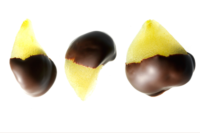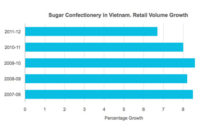Candy is an indulgence. That’s a widely-known and accepted fact. But that doesn’t mean the comforting sweetness of confectionery and the benefits of healthy ingredients are mutually exclusive.
Manufacturers are increasingly trying to add nutrition to their treats, trying to meet consumer demand for good, healthy snacking.
“Do a search for protein and chocolate and you will find a wide array of nutrition and snack bars with a protein chocolatey drizzle, coating or inclusion,” says Katy Cole, technical service manager, Cargill Cocoa & Chocolate.
Packing candy with protein has yet to take off, but it’s an important trend in the snack bar category, which appeals to consumers through high nutritional content for more on-the-go lifestyles.
“Consumers are looking for foods with health benefits, and protein is often at the top of their list. Chocolate and protein pair well together, and Wilbur protein coatings and inclusions offer versatile product solutions that are suitable for a variety of applications and may help contribute to a protein nutrient content claim,” says Cole.
And, in compounds, proteins can replace sugar. By increasing protein content, it’s possible to reduce sugar by 25 percent and offer product developers a tool to address growing concerns over added sugar.
The protein craze shows no sign of slowing, Cole adds, especially among health-conscious consumers. Meanwhile, American consumers are becoming increasingly open to plant-based proteins. Whey is still the go-to source, but there’s increasing interest in using other natural sources like pea protein.
But although pea protein might not break in any time soon, the candy sector is also on a hunt for innovative ways to include healthy ingredients into its treats. One way to go about it is to make the old new again.
Earlier this year, Nestlé brought Damak to market. Damak is a Turkish brand with 80 years of rich history in chocolate and pistachios that taps into Turkey’s centuries-old traditions with the nut. It’s a nut that has been eaten for nearly 9,000 years and is now making another push into the mainstream market.
As with most nuts, pistachios are packed with nutrients. A ¼ cup serving is 160 cal., and has 8 g. of carbohydrates, 3 g. of fiber, and 6 g. of protein. The fat it contains is mostly healthy monounsaturated and polyunsaturated fats, which can help lower cholesterol. They’re also a good source of iron, which improves oxygen storage and delivery throughout the body.
And if we’re talking about nuts, there are also almonds, one of the most popular inclusions in candy.
“In a survey conducted by the Almond Board of California, 77 percent of consumers perceive almonds to be the most healthful nut,” says Jeff Smith, director of marketing, Blue Diamond Almonds Global Ingredients Division.
"They ranked them highest among nuts for being nutritious, a key source of energy and heart healthy – all of which make them a candy inclusion that fulfills on the side of health and indulgence.”
When compared ounce for ounce, almonds are the tree nut highest in protein (6 g.), fiber (4 g.), calcium (75 mg.), vitamin E (7.4 mg.), riboflavin (0.3 mg.) And niacin (1 mg.). They are also an excellent source of magnesium (75 mg.).
Almonds are also incredibly versatile. They can be found in enrobed chocolate, chocolate bars or in a panned type of candy product. They can be used whole, sliced, or diced, in a paste, or in butter form.
“In 2014, almonds accounted for 54 percent of all chocolate with nut occasions, and a significant 31 percent of total chocolate occasions,” says Smith. “This means that almonds are a smart choice for manufacturers creating products appealing to a wide swath of consumers.”
Their popularity comes in part from the versatility, and in part from their unique ability to carry flavor, both savory and sweet, while adding nutrition and enhancing a product’s premium position.
“Creativity and innovation are happening continuously in all areas of candy formulations. For formulators and developers, a unique almond attribute is their ability to carry flavor,” Smith adds. “New flavor profiles for almond inclusions could potentially influence new flavors in candy products themselves—flavor combinations we have not considered before.”
But almonds, of course, are not the only versatile inclusions. Fruits are, in many ways, a significant presence in consumers’ lives and are likely to stay that way.
According to “Fresh Takes on Fruit: Culinary Trend Mapping Report,” a joint publication of CCD Innovation and market research publisher Packaged Facts, “Fruit is and will continue to be omnipresent. Fruit plays a role in every daypart from breakfast to late-night snacks. Fruits go from the produce aisles to the snack shelf and freezer case. It is transformed into beverages, condiments and baked goods of all kinds. They also appeal to all ages and demographics.”
And blueberries, specifically, can be paired with many confections.
According to the U.S. Highbush Blueberry Council, these fruits are nutritionally dense, containing 14 g. of carbohydrates per 100 g. They’re low in calories, virtually fat-free, and contain no cholesterol while being a good source of fiber, vitamins, minerals, and antioxidants.
And while blueberries already co-star with dark chocolate in many types of confections, they can work well with a wide range of flavors, including spices, botanicals, floral, citrus, and herbaceous profiles. Their sweetness adds excitement to new, innovative products. They’re also synergistic with oats, amaranth, buckwheat, chia, millet, quinoa, sorghum, and can serve as the basis for vegan snacks, gluten-free products, and other special diet foods.
Their popularity is not limited to the United States. In the Middle East, they can be found in Turkish Delight. They’ve also made their way into traditional Japanese candy, wagashi, and into modernized Chinese moon cakes featuring blueberry paste.
There’s a wholesomeness to blueberries that make them both old and new, and that’s an important reputation they can capitalize on. From their association with homey wholesomeness to their healthy appeal, blueberries get all the love.
Healthy Inclusions
Healthy snacks spurs growth of healthy inclusions
As demand for healthy snacking grows, so does desire to create sweets with healthier nutrition profiles.

Photo provided by Blue Diamond Almonds.

Photo provided by U.S. Highbush Blueberry Council.

Photo of caramel inclusions provided by Cargill.




